Strategic Issues and Solutions in 13Cabs: An Australian Taxi Network
VerifiedAdded on 2020/05/08
|15
|3431
|82
AI Summary
13Cabs, an Australian taxi network, confronts several strategic challenges including environmental sustainability, emerging technologies, and intense market competition. The report evaluates these issues and explores potential solutions such as implementing comprehensive training programs for employees, integrating technologically advanced engines to minimize emissions, and adopting a low pricing strategy to enhance competitiveness. These strategies aim to balance positive impacts with potential drawbacks, influenced by global awareness, technology adoption, and global market penetration.
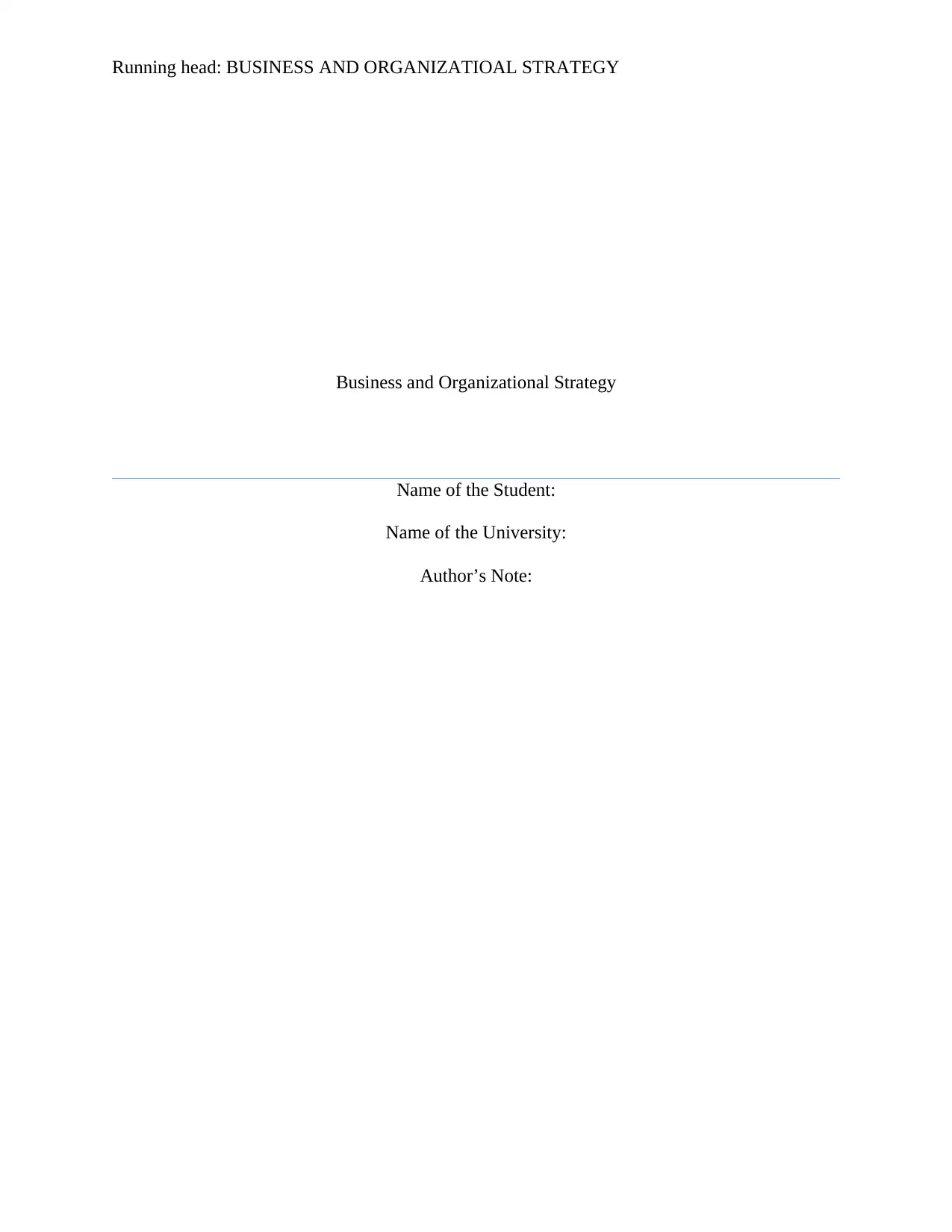
Running head: BUSINESS AND ORGANIZATIOAL STRATEGY
Business and Organizational Strategy
Name of the Student:
Name of the University:
Author’s Note:
Business and Organizational Strategy
Name of the Student:
Name of the University:
Author’s Note:
Paraphrase This Document
Need a fresh take? Get an instant paraphrase of this document with our AI Paraphraser
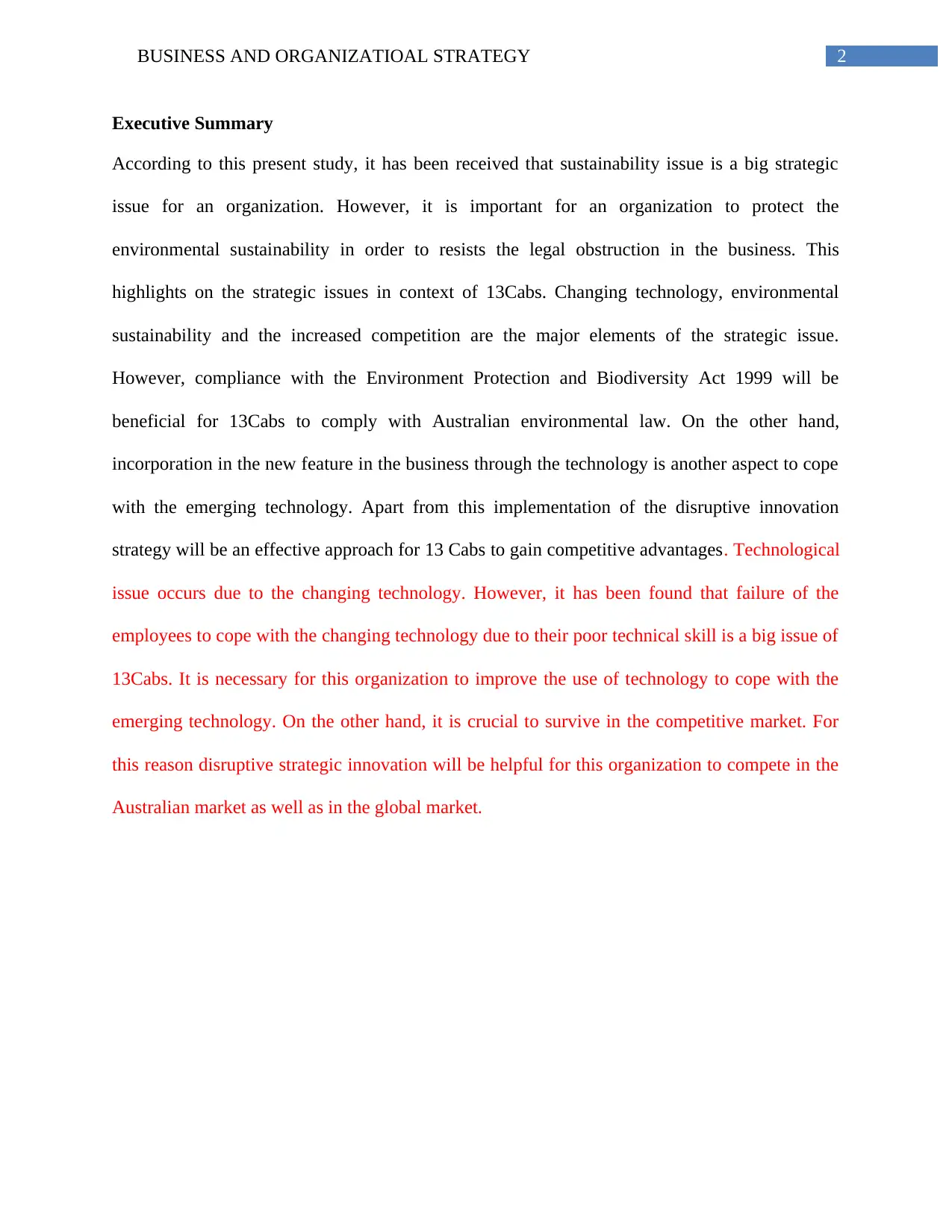
2BUSINESS AND ORGANIZATIOAL STRATEGY
Executive Summary
According to this present study, it has been received that sustainability issue is a big strategic
issue for an organization. However, it is important for an organization to protect the
environmental sustainability in order to resists the legal obstruction in the business. This
highlights on the strategic issues in context of 13Cabs. Changing technology, environmental
sustainability and the increased competition are the major elements of the strategic issue.
However, compliance with the Environment Protection and Biodiversity Act 1999 will be
beneficial for 13Cabs to comply with Australian environmental law. On the other hand,
incorporation in the new feature in the business through the technology is another aspect to cope
with the emerging technology. Apart from this implementation of the disruptive innovation
strategy will be an effective approach for 13 Cabs to gain competitive advantages. Technological
issue occurs due to the changing technology. However, it has been found that failure of the
employees to cope with the changing technology due to their poor technical skill is a big issue of
13Cabs. It is necessary for this organization to improve the use of technology to cope with the
emerging technology. On the other hand, it is crucial to survive in the competitive market. For
this reason disruptive strategic innovation will be helpful for this organization to compete in the
Australian market as well as in the global market.
Executive Summary
According to this present study, it has been received that sustainability issue is a big strategic
issue for an organization. However, it is important for an organization to protect the
environmental sustainability in order to resists the legal obstruction in the business. This
highlights on the strategic issues in context of 13Cabs. Changing technology, environmental
sustainability and the increased competition are the major elements of the strategic issue.
However, compliance with the Environment Protection and Biodiversity Act 1999 will be
beneficial for 13Cabs to comply with Australian environmental law. On the other hand,
incorporation in the new feature in the business through the technology is another aspect to cope
with the emerging technology. Apart from this implementation of the disruptive innovation
strategy will be an effective approach for 13 Cabs to gain competitive advantages. Technological
issue occurs due to the changing technology. However, it has been found that failure of the
employees to cope with the changing technology due to their poor technical skill is a big issue of
13Cabs. It is necessary for this organization to improve the use of technology to cope with the
emerging technology. On the other hand, it is crucial to survive in the competitive market. For
this reason disruptive strategic innovation will be helpful for this organization to compete in the
Australian market as well as in the global market.
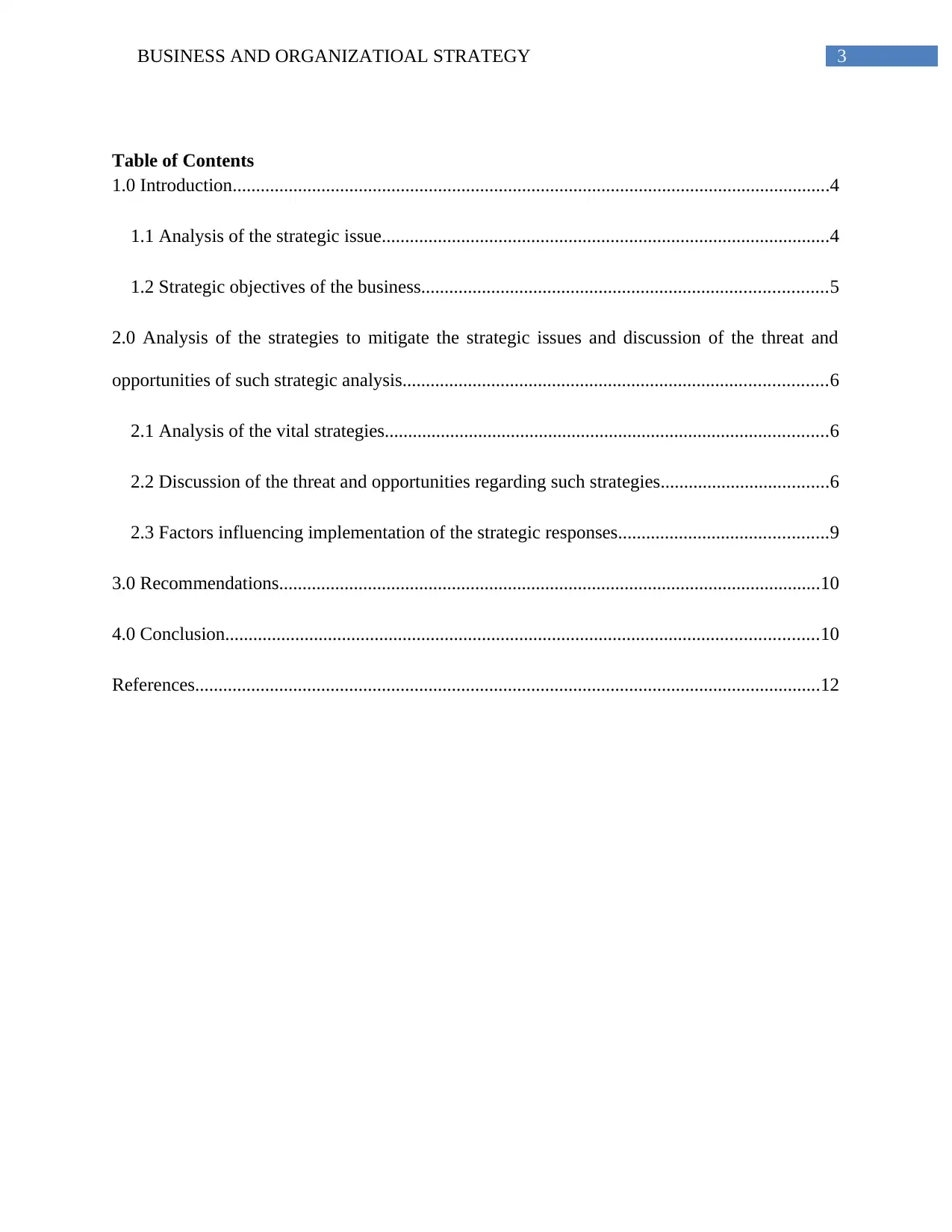
3BUSINESS AND ORGANIZATIOAL STRATEGY
Table of Contents
1.0 Introduction................................................................................................................................4
1.1 Analysis of the strategic issue................................................................................................4
1.2 Strategic objectives of the business.......................................................................................5
2.0 Analysis of the strategies to mitigate the strategic issues and discussion of the threat and
opportunities of such strategic analysis...........................................................................................6
2.1 Analysis of the vital strategies...............................................................................................6
2.2 Discussion of the threat and opportunities regarding such strategies....................................6
2.3 Factors influencing implementation of the strategic responses.............................................9
3.0 Recommendations....................................................................................................................10
4.0 Conclusion...............................................................................................................................10
References......................................................................................................................................12
Table of Contents
1.0 Introduction................................................................................................................................4
1.1 Analysis of the strategic issue................................................................................................4
1.2 Strategic objectives of the business.......................................................................................5
2.0 Analysis of the strategies to mitigate the strategic issues and discussion of the threat and
opportunities of such strategic analysis...........................................................................................6
2.1 Analysis of the vital strategies...............................................................................................6
2.2 Discussion of the threat and opportunities regarding such strategies....................................6
2.3 Factors influencing implementation of the strategic responses.............................................9
3.0 Recommendations....................................................................................................................10
4.0 Conclusion...............................................................................................................................10
References......................................................................................................................................12
You're viewing a preview
Unlock full access by subscribing today!
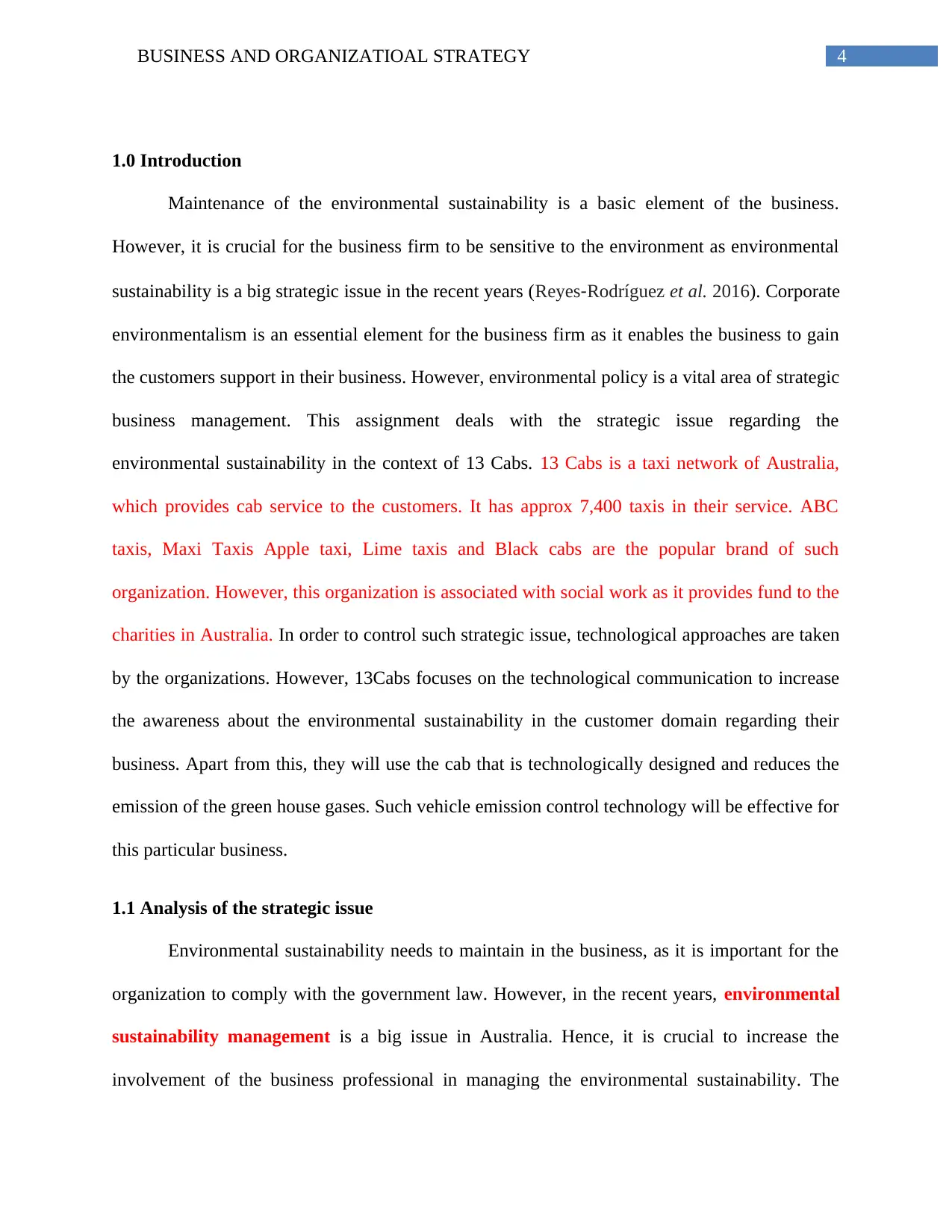
4BUSINESS AND ORGANIZATIOAL STRATEGY
1.0 Introduction
Maintenance of the environmental sustainability is a basic element of the business.
However, it is crucial for the business firm to be sensitive to the environment as environmental
sustainability is a big strategic issue in the recent years (Reyes‐Rodríguez et al. 2016). Corporate
environmentalism is an essential element for the business firm as it enables the business to gain
the customers support in their business. However, environmental policy is a vital area of strategic
business management. This assignment deals with the strategic issue regarding the
environmental sustainability in the context of 13 Cabs. 13 Cabs is a taxi network of Australia,
which provides cab service to the customers. It has approx 7,400 taxis in their service. ABC
taxis, Maxi Taxis Apple taxi, Lime taxis and Black cabs are the popular brand of such
organization. However, this organization is associated with social work as it provides fund to the
charities in Australia. In order to control such strategic issue, technological approaches are taken
by the organizations. However, 13Cabs focuses on the technological communication to increase
the awareness about the environmental sustainability in the customer domain regarding their
business. Apart from this, they will use the cab that is technologically designed and reduces the
emission of the green house gases. Such vehicle emission control technology will be effective for
this particular business.
1.1 Analysis of the strategic issue
Environmental sustainability needs to maintain in the business, as it is important for the
organization to comply with the government law. However, in the recent years, environmental
sustainability management is a big issue in Australia. Hence, it is crucial to increase the
involvement of the business professional in managing the environmental sustainability. The
1.0 Introduction
Maintenance of the environmental sustainability is a basic element of the business.
However, it is crucial for the business firm to be sensitive to the environment as environmental
sustainability is a big strategic issue in the recent years (Reyes‐Rodríguez et al. 2016). Corporate
environmentalism is an essential element for the business firm as it enables the business to gain
the customers support in their business. However, environmental policy is a vital area of strategic
business management. This assignment deals with the strategic issue regarding the
environmental sustainability in the context of 13 Cabs. 13 Cabs is a taxi network of Australia,
which provides cab service to the customers. It has approx 7,400 taxis in their service. ABC
taxis, Maxi Taxis Apple taxi, Lime taxis and Black cabs are the popular brand of such
organization. However, this organization is associated with social work as it provides fund to the
charities in Australia. In order to control such strategic issue, technological approaches are taken
by the organizations. However, 13Cabs focuses on the technological communication to increase
the awareness about the environmental sustainability in the customer domain regarding their
business. Apart from this, they will use the cab that is technologically designed and reduces the
emission of the green house gases. Such vehicle emission control technology will be effective for
this particular business.
1.1 Analysis of the strategic issue
Environmental sustainability needs to maintain in the business, as it is important for the
organization to comply with the government law. However, in the recent years, environmental
sustainability management is a big issue in Australia. Hence, it is crucial to increase the
involvement of the business professional in managing the environmental sustainability. The
Paraphrase This Document
Need a fresh take? Get an instant paraphrase of this document with our AI Paraphraser
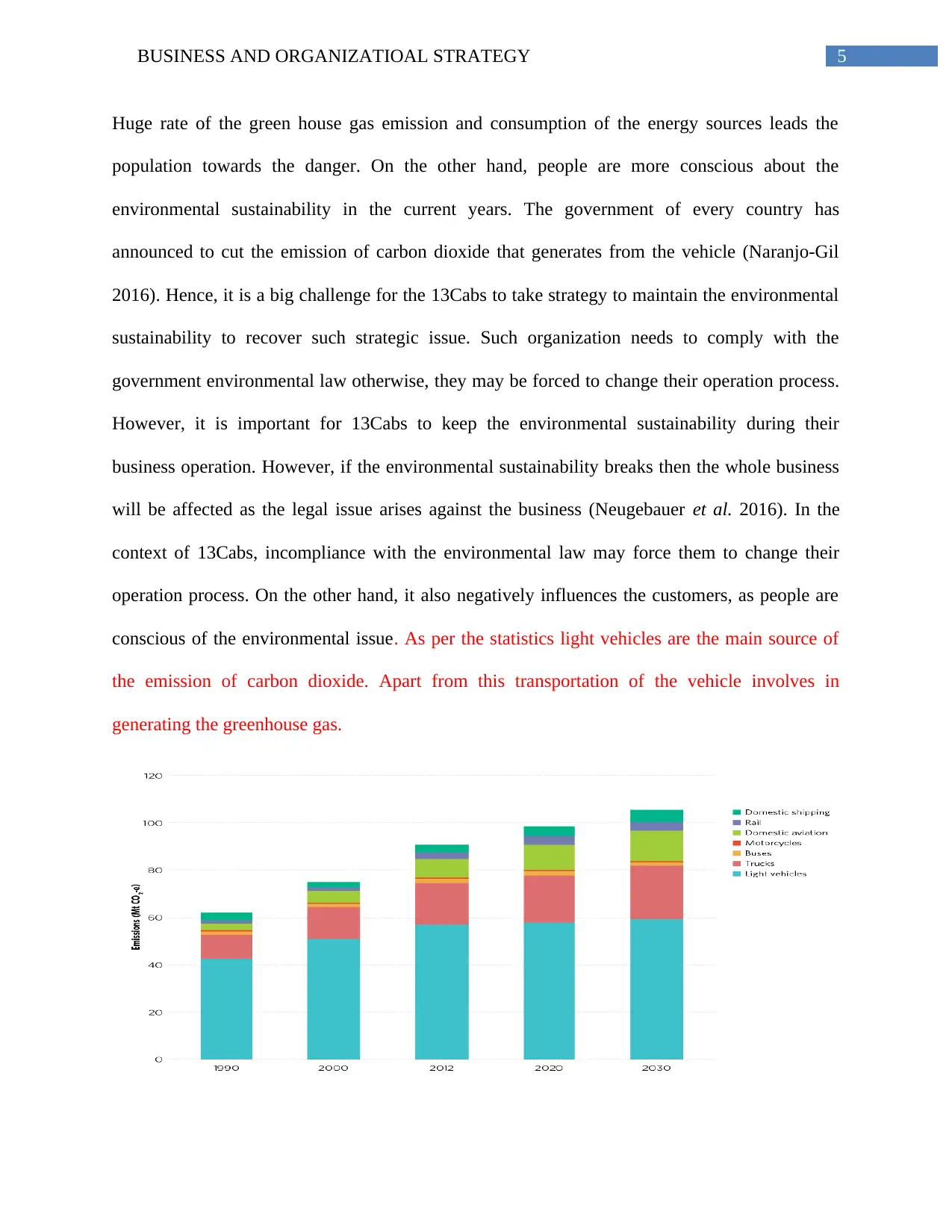
5BUSINESS AND ORGANIZATIOAL STRATEGY
Huge rate of the green house gas emission and consumption of the energy sources leads the
population towards the danger. On the other hand, people are more conscious about the
environmental sustainability in the current years. The government of every country has
announced to cut the emission of carbon dioxide that generates from the vehicle (Naranjo-Gil
2016). Hence, it is a big challenge for the 13Cabs to take strategy to maintain the environmental
sustainability to recover such strategic issue. Such organization needs to comply with the
government environmental law otherwise, they may be forced to change their operation process.
However, it is important for 13Cabs to keep the environmental sustainability during their
business operation. However, if the environmental sustainability breaks then the whole business
will be affected as the legal issue arises against the business (Neugebauer et al. 2016). In the
context of 13Cabs, incompliance with the environmental law may force them to change their
operation process. On the other hand, it also negatively influences the customers, as people are
conscious of the environmental issue. As per the statistics light vehicles are the main source of
the emission of carbon dioxide. Apart from this transportation of the vehicle involves in
generating the greenhouse gas.
Huge rate of the green house gas emission and consumption of the energy sources leads the
population towards the danger. On the other hand, people are more conscious about the
environmental sustainability in the current years. The government of every country has
announced to cut the emission of carbon dioxide that generates from the vehicle (Naranjo-Gil
2016). Hence, it is a big challenge for the 13Cabs to take strategy to maintain the environmental
sustainability to recover such strategic issue. Such organization needs to comply with the
government environmental law otherwise, they may be forced to change their operation process.
However, it is important for 13Cabs to keep the environmental sustainability during their
business operation. However, if the environmental sustainability breaks then the whole business
will be affected as the legal issue arises against the business (Neugebauer et al. 2016). In the
context of 13Cabs, incompliance with the environmental law may force them to change their
operation process. On the other hand, it also negatively influences the customers, as people are
conscious of the environmental issue. As per the statistics light vehicles are the main source of
the emission of carbon dioxide. Apart from this transportation of the vehicle involves in
generating the greenhouse gas.
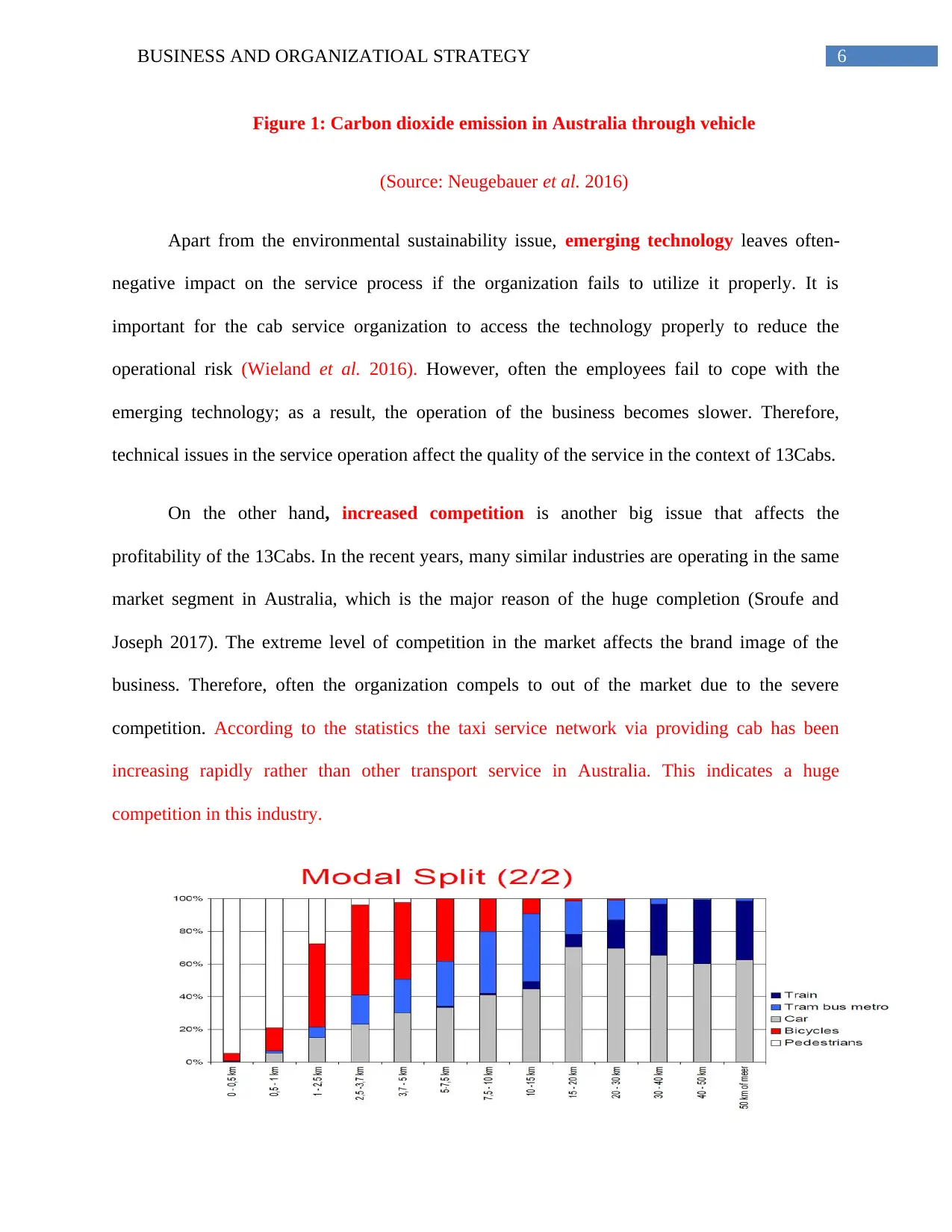
6BUSINESS AND ORGANIZATIOAL STRATEGY
Figure 1: Carbon dioxide emission in Australia through vehicle
(Source: Neugebauer et al. 2016)
Apart from the environmental sustainability issue, emerging technology leaves often-
negative impact on the service process if the organization fails to utilize it properly. It is
important for the cab service organization to access the technology properly to reduce the
operational risk (Wieland et al. 2016). However, often the employees fail to cope with the
emerging technology; as a result, the operation of the business becomes slower. Therefore,
technical issues in the service operation affect the quality of the service in the context of 13Cabs.
On the other hand, increased competition is another big issue that affects the
profitability of the 13Cabs. In the recent years, many similar industries are operating in the same
market segment in Australia, which is the major reason of the huge completion (Sroufe and
Joseph 2017). The extreme level of competition in the market affects the brand image of the
business. Therefore, often the organization compels to out of the market due to the severe
competition. According to the statistics the taxi service network via providing cab has been
increasing rapidly rather than other transport service in Australia. This indicates a huge
competition in this industry.
Figure 1: Carbon dioxide emission in Australia through vehicle
(Source: Neugebauer et al. 2016)
Apart from the environmental sustainability issue, emerging technology leaves often-
negative impact on the service process if the organization fails to utilize it properly. It is
important for the cab service organization to access the technology properly to reduce the
operational risk (Wieland et al. 2016). However, often the employees fail to cope with the
emerging technology; as a result, the operation of the business becomes slower. Therefore,
technical issues in the service operation affect the quality of the service in the context of 13Cabs.
On the other hand, increased competition is another big issue that affects the
profitability of the 13Cabs. In the recent years, many similar industries are operating in the same
market segment in Australia, which is the major reason of the huge completion (Sroufe and
Joseph 2017). The extreme level of competition in the market affects the brand image of the
business. Therefore, often the organization compels to out of the market due to the severe
competition. According to the statistics the taxi service network via providing cab has been
increasing rapidly rather than other transport service in Australia. This indicates a huge
competition in this industry.
You're viewing a preview
Unlock full access by subscribing today!
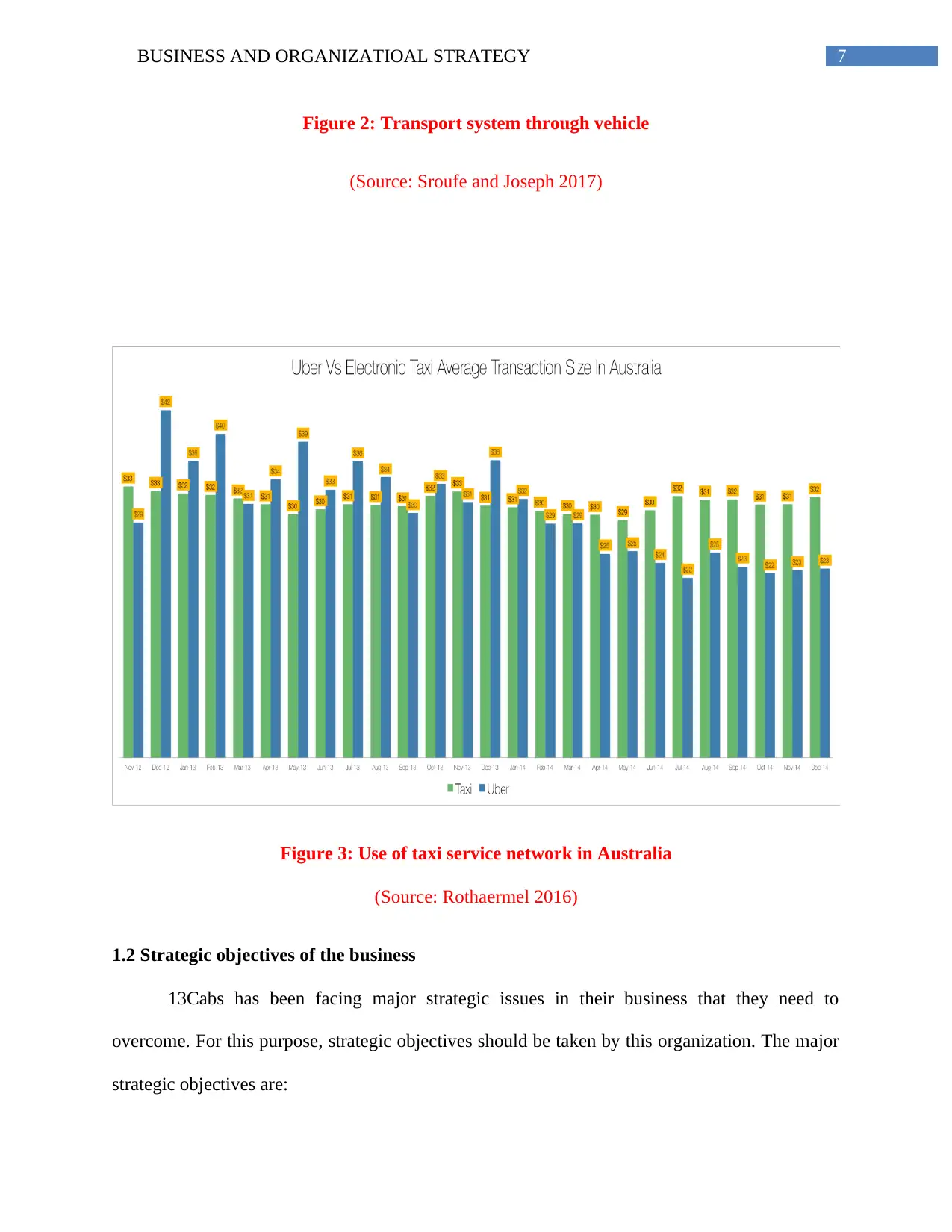
7BUSINESS AND ORGANIZATIOAL STRATEGY
Figure 2: Transport system through vehicle
(Source: Sroufe and Joseph 2017)
Figure 3: Use of taxi service network in Australia
(Source: Rothaermel 2016)
1.2 Strategic objectives of the business
13Cabs has been facing major strategic issues in their business that they need to
overcome. For this purpose, strategic objectives should be taken by this organization. The major
strategic objectives are:
Figure 2: Transport system through vehicle
(Source: Sroufe and Joseph 2017)
Figure 3: Use of taxi service network in Australia
(Source: Rothaermel 2016)
1.2 Strategic objectives of the business
13Cabs has been facing major strategic issues in their business that they need to
overcome. For this purpose, strategic objectives should be taken by this organization. The major
strategic objectives are:
Paraphrase This Document
Need a fresh take? Get an instant paraphrase of this document with our AI Paraphraser
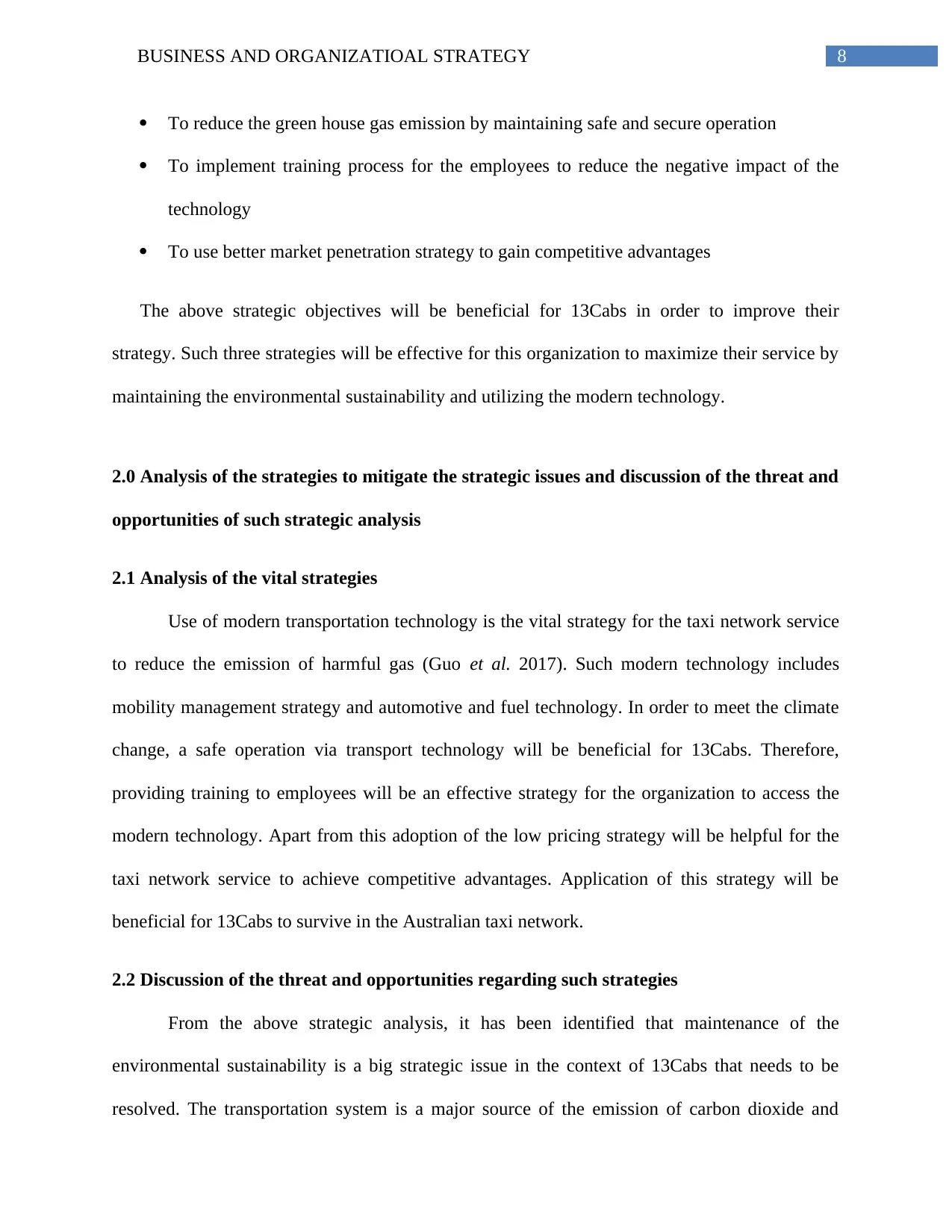
8BUSINESS AND ORGANIZATIOAL STRATEGY
To reduce the green house gas emission by maintaining safe and secure operation
To implement training process for the employees to reduce the negative impact of the
technology
To use better market penetration strategy to gain competitive advantages
The above strategic objectives will be beneficial for 13Cabs in order to improve their
strategy. Such three strategies will be effective for this organization to maximize their service by
maintaining the environmental sustainability and utilizing the modern technology.
2.0 Analysis of the strategies to mitigate the strategic issues and discussion of the threat and
opportunities of such strategic analysis
2.1 Analysis of the vital strategies
Use of modern transportation technology is the vital strategy for the taxi network service
to reduce the emission of harmful gas (Guo et al. 2017). Such modern technology includes
mobility management strategy and automotive and fuel technology. In order to meet the climate
change, a safe operation via transport technology will be beneficial for 13Cabs. Therefore,
providing training to employees will be an effective strategy for the organization to access the
modern technology. Apart from this adoption of the low pricing strategy will be helpful for the
taxi network service to achieve competitive advantages. Application of this strategy will be
beneficial for 13Cabs to survive in the Australian taxi network.
2.2 Discussion of the threat and opportunities regarding such strategies
From the above strategic analysis, it has been identified that maintenance of the
environmental sustainability is a big strategic issue in the context of 13Cabs that needs to be
resolved. The transportation system is a major source of the emission of carbon dioxide and
To reduce the green house gas emission by maintaining safe and secure operation
To implement training process for the employees to reduce the negative impact of the
technology
To use better market penetration strategy to gain competitive advantages
The above strategic objectives will be beneficial for 13Cabs in order to improve their
strategy. Such three strategies will be effective for this organization to maximize their service by
maintaining the environmental sustainability and utilizing the modern technology.
2.0 Analysis of the strategies to mitigate the strategic issues and discussion of the threat and
opportunities of such strategic analysis
2.1 Analysis of the vital strategies
Use of modern transportation technology is the vital strategy for the taxi network service
to reduce the emission of harmful gas (Guo et al. 2017). Such modern technology includes
mobility management strategy and automotive and fuel technology. In order to meet the climate
change, a safe operation via transport technology will be beneficial for 13Cabs. Therefore,
providing training to employees will be an effective strategy for the organization to access the
modern technology. Apart from this adoption of the low pricing strategy will be helpful for the
taxi network service to achieve competitive advantages. Application of this strategy will be
beneficial for 13Cabs to survive in the Australian taxi network.
2.2 Discussion of the threat and opportunities regarding such strategies
From the above strategic analysis, it has been identified that maintenance of the
environmental sustainability is a big strategic issue in the context of 13Cabs that needs to be
resolved. The transportation system is a major source of the emission of carbon dioxide and
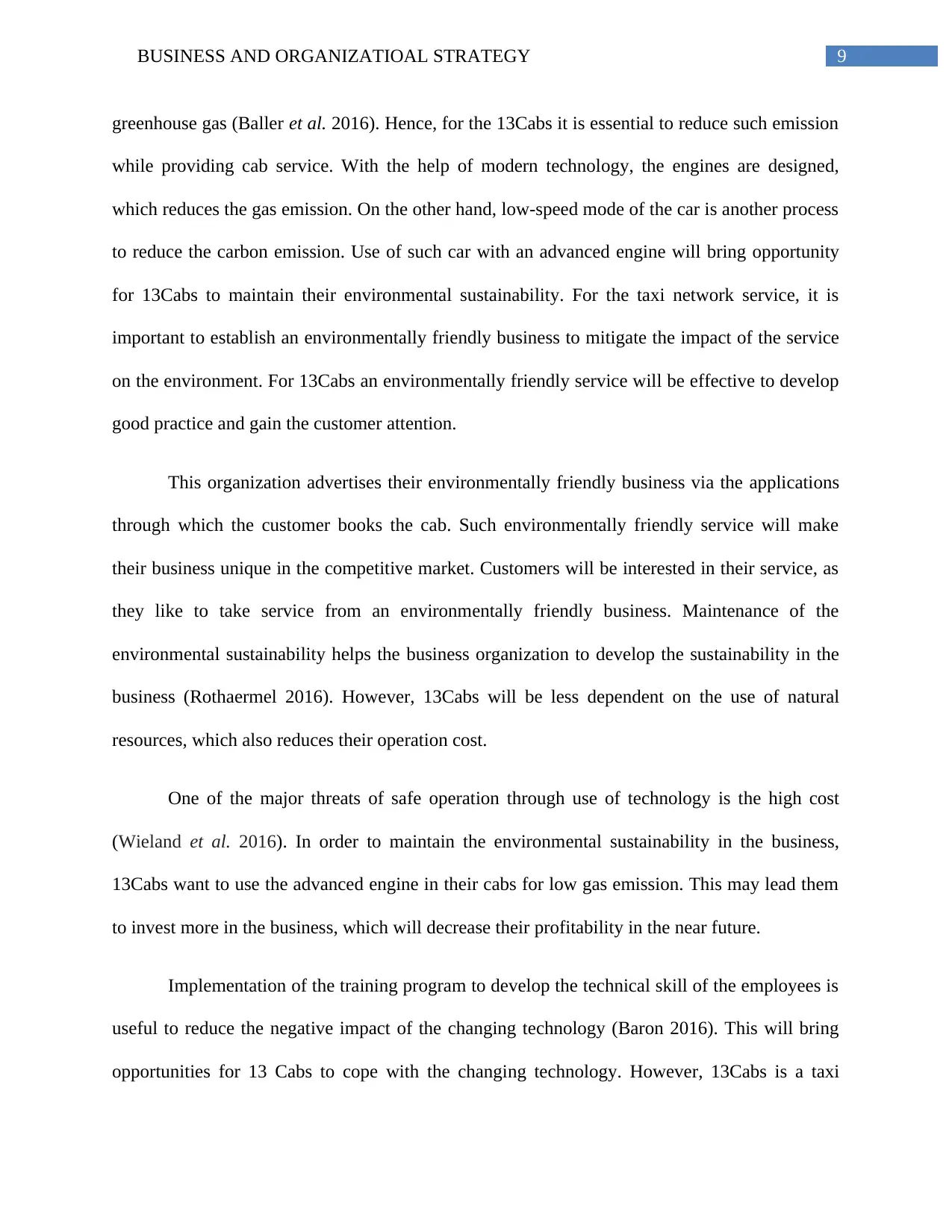
9BUSINESS AND ORGANIZATIOAL STRATEGY
greenhouse gas (Baller et al. 2016). Hence, for the 13Cabs it is essential to reduce such emission
while providing cab service. With the help of modern technology, the engines are designed,
which reduces the gas emission. On the other hand, low-speed mode of the car is another process
to reduce the carbon emission. Use of such car with an advanced engine will bring opportunity
for 13Cabs to maintain their environmental sustainability. For the taxi network service, it is
important to establish an environmentally friendly business to mitigate the impact of the service
on the environment. For 13Cabs an environmentally friendly service will be effective to develop
good practice and gain the customer attention.
This organization advertises their environmentally friendly business via the applications
through which the customer books the cab. Such environmentally friendly service will make
their business unique in the competitive market. Customers will be interested in their service, as
they like to take service from an environmentally friendly business. Maintenance of the
environmental sustainability helps the business organization to develop the sustainability in the
business (Rothaermel 2016). However, 13Cabs will be less dependent on the use of natural
resources, which also reduces their operation cost.
One of the major threats of safe operation through use of technology is the high cost
(Wieland et al. 2016). In order to maintain the environmental sustainability in the business,
13Cabs want to use the advanced engine in their cabs for low gas emission. This may lead them
to invest more in the business, which will decrease their profitability in the near future.
Implementation of the training program to develop the technical skill of the employees is
useful to reduce the negative impact of the changing technology (Baron 2016). This will bring
opportunities for 13 Cabs to cope with the changing technology. However, 13Cabs is a taxi
greenhouse gas (Baller et al. 2016). Hence, for the 13Cabs it is essential to reduce such emission
while providing cab service. With the help of modern technology, the engines are designed,
which reduces the gas emission. On the other hand, low-speed mode of the car is another process
to reduce the carbon emission. Use of such car with an advanced engine will bring opportunity
for 13Cabs to maintain their environmental sustainability. For the taxi network service, it is
important to establish an environmentally friendly business to mitigate the impact of the service
on the environment. For 13Cabs an environmentally friendly service will be effective to develop
good practice and gain the customer attention.
This organization advertises their environmentally friendly business via the applications
through which the customer books the cab. Such environmentally friendly service will make
their business unique in the competitive market. Customers will be interested in their service, as
they like to take service from an environmentally friendly business. Maintenance of the
environmental sustainability helps the business organization to develop the sustainability in the
business (Rothaermel 2016). However, 13Cabs will be less dependent on the use of natural
resources, which also reduces their operation cost.
One of the major threats of safe operation through use of technology is the high cost
(Wieland et al. 2016). In order to maintain the environmental sustainability in the business,
13Cabs want to use the advanced engine in their cabs for low gas emission. This may lead them
to invest more in the business, which will decrease their profitability in the near future.
Implementation of the training program to develop the technical skill of the employees is
useful to reduce the negative impact of the changing technology (Baron 2016). This will bring
opportunities for 13 Cabs to cope with the changing technology. However, 13Cabs is a taxi
You're viewing a preview
Unlock full access by subscribing today!
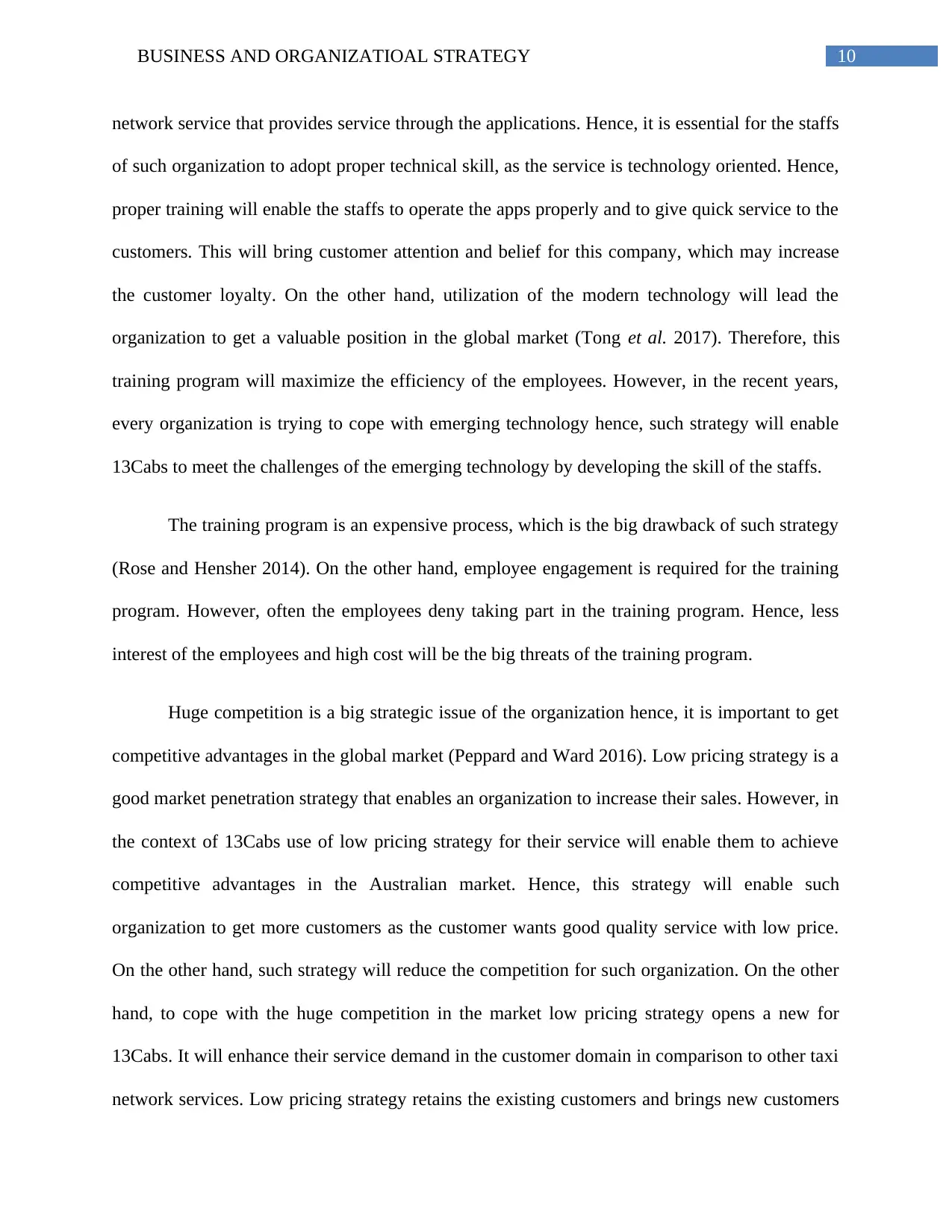
10BUSINESS AND ORGANIZATIOAL STRATEGY
network service that provides service through the applications. Hence, it is essential for the staffs
of such organization to adopt proper technical skill, as the service is technology oriented. Hence,
proper training will enable the staffs to operate the apps properly and to give quick service to the
customers. This will bring customer attention and belief for this company, which may increase
the customer loyalty. On the other hand, utilization of the modern technology will lead the
organization to get a valuable position in the global market (Tong et al. 2017). Therefore, this
training program will maximize the efficiency of the employees. However, in the recent years,
every organization is trying to cope with emerging technology hence, such strategy will enable
13Cabs to meet the challenges of the emerging technology by developing the skill of the staffs.
The training program is an expensive process, which is the big drawback of such strategy
(Rose and Hensher 2014). On the other hand, employee engagement is required for the training
program. However, often the employees deny taking part in the training program. Hence, less
interest of the employees and high cost will be the big threats of the training program.
Huge competition is a big strategic issue of the organization hence, it is important to get
competitive advantages in the global market (Peppard and Ward 2016). Low pricing strategy is a
good market penetration strategy that enables an organization to increase their sales. However, in
the context of 13Cabs use of low pricing strategy for their service will enable them to achieve
competitive advantages in the Australian market. Hence, this strategy will enable such
organization to get more customers as the customer wants good quality service with low price.
On the other hand, such strategy will reduce the competition for such organization. On the other
hand, to cope with the huge competition in the market low pricing strategy opens a new for
13Cabs. It will enhance their service demand in the customer domain in comparison to other taxi
network services. Low pricing strategy retains the existing customers and brings new customers
network service that provides service through the applications. Hence, it is essential for the staffs
of such organization to adopt proper technical skill, as the service is technology oriented. Hence,
proper training will enable the staffs to operate the apps properly and to give quick service to the
customers. This will bring customer attention and belief for this company, which may increase
the customer loyalty. On the other hand, utilization of the modern technology will lead the
organization to get a valuable position in the global market (Tong et al. 2017). Therefore, this
training program will maximize the efficiency of the employees. However, in the recent years,
every organization is trying to cope with emerging technology hence, such strategy will enable
13Cabs to meet the challenges of the emerging technology by developing the skill of the staffs.
The training program is an expensive process, which is the big drawback of such strategy
(Rose and Hensher 2014). On the other hand, employee engagement is required for the training
program. However, often the employees deny taking part in the training program. Hence, less
interest of the employees and high cost will be the big threats of the training program.
Huge competition is a big strategic issue of the organization hence, it is important to get
competitive advantages in the global market (Peppard and Ward 2016). Low pricing strategy is a
good market penetration strategy that enables an organization to increase their sales. However, in
the context of 13Cabs use of low pricing strategy for their service will enable them to achieve
competitive advantages in the Australian market. Hence, this strategy will enable such
organization to get more customers as the customer wants good quality service with low price.
On the other hand, such strategy will reduce the competition for such organization. On the other
hand, to cope with the huge competition in the market low pricing strategy opens a new for
13Cabs. It will enhance their service demand in the customer domain in comparison to other taxi
network services. Low pricing strategy retains the existing customers and brings new customers
Paraphrase This Document
Need a fresh take? Get an instant paraphrase of this document with our AI Paraphraser
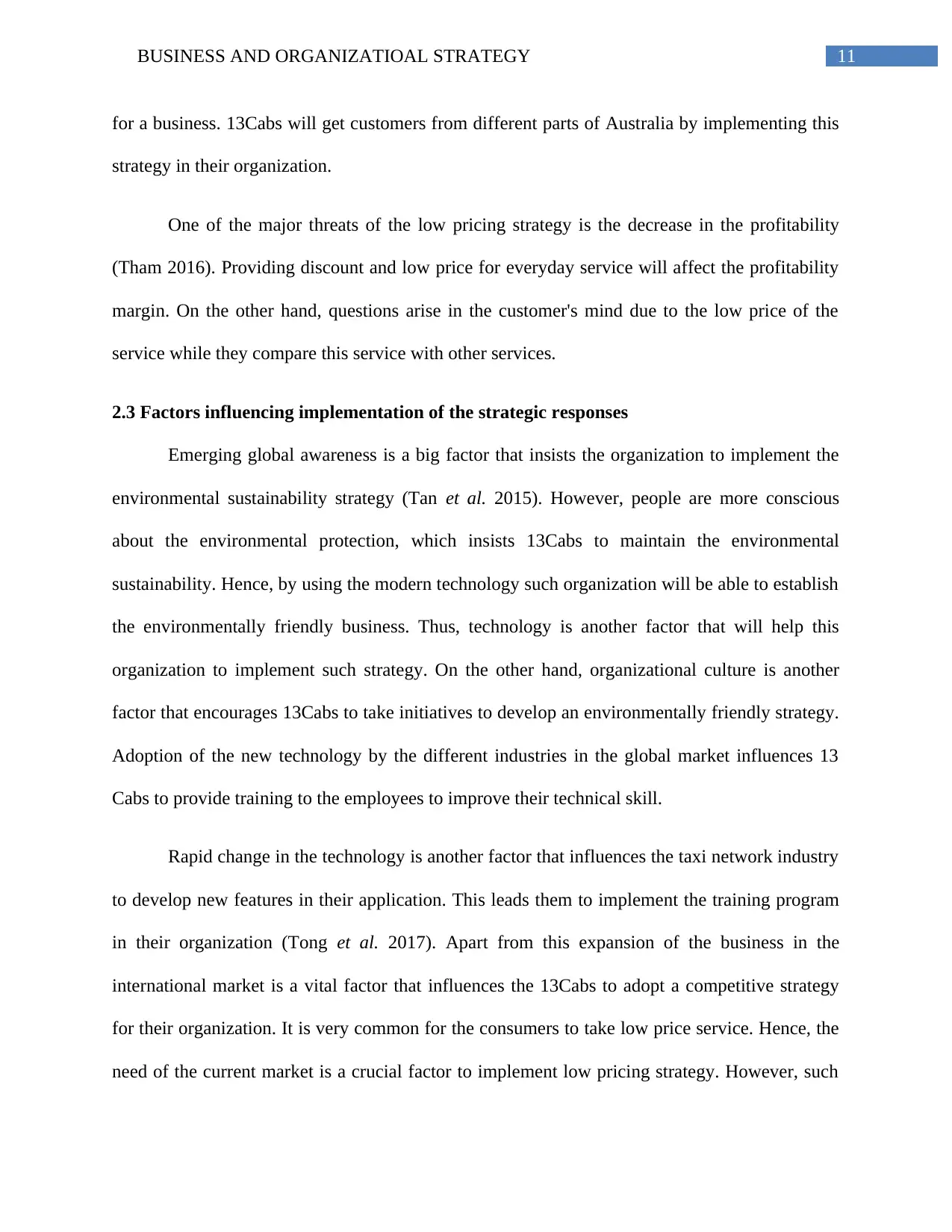
11BUSINESS AND ORGANIZATIOAL STRATEGY
for a business. 13Cabs will get customers from different parts of Australia by implementing this
strategy in their organization.
One of the major threats of the low pricing strategy is the decrease in the profitability
(Tham 2016). Providing discount and low price for everyday service will affect the profitability
margin. On the other hand, questions arise in the customer's mind due to the low price of the
service while they compare this service with other services.
2.3 Factors influencing implementation of the strategic responses
Emerging global awareness is a big factor that insists the organization to implement the
environmental sustainability strategy (Tan et al. 2015). However, people are more conscious
about the environmental protection, which insists 13Cabs to maintain the environmental
sustainability. Hence, by using the modern technology such organization will be able to establish
the environmentally friendly business. Thus, technology is another factor that will help this
organization to implement such strategy. On the other hand, organizational culture is another
factor that encourages 13Cabs to take initiatives to develop an environmentally friendly strategy.
Adoption of the new technology by the different industries in the global market influences 13
Cabs to provide training to the employees to improve their technical skill.
Rapid change in the technology is another factor that influences the taxi network industry
to develop new features in their application. This leads them to implement the training program
in their organization (Tong et al. 2017). Apart from this expansion of the business in the
international market is a vital factor that influences the 13Cabs to adopt a competitive strategy
for their organization. It is very common for the consumers to take low price service. Hence, the
need of the current market is a crucial factor to implement low pricing strategy. However, such
for a business. 13Cabs will get customers from different parts of Australia by implementing this
strategy in their organization.
One of the major threats of the low pricing strategy is the decrease in the profitability
(Tham 2016). Providing discount and low price for everyday service will affect the profitability
margin. On the other hand, questions arise in the customer's mind due to the low price of the
service while they compare this service with other services.
2.3 Factors influencing implementation of the strategic responses
Emerging global awareness is a big factor that insists the organization to implement the
environmental sustainability strategy (Tan et al. 2015). However, people are more conscious
about the environmental protection, which insists 13Cabs to maintain the environmental
sustainability. Hence, by using the modern technology such organization will be able to establish
the environmentally friendly business. Thus, technology is another factor that will help this
organization to implement such strategy. On the other hand, organizational culture is another
factor that encourages 13Cabs to take initiatives to develop an environmentally friendly strategy.
Adoption of the new technology by the different industries in the global market influences 13
Cabs to provide training to the employees to improve their technical skill.
Rapid change in the technology is another factor that influences the taxi network industry
to develop new features in their application. This leads them to implement the training program
in their organization (Tong et al. 2017). Apart from this expansion of the business in the
international market is a vital factor that influences the 13Cabs to adopt a competitive strategy
for their organization. It is very common for the consumers to take low price service. Hence, the
need of the current market is a crucial factor to implement low pricing strategy. However, such
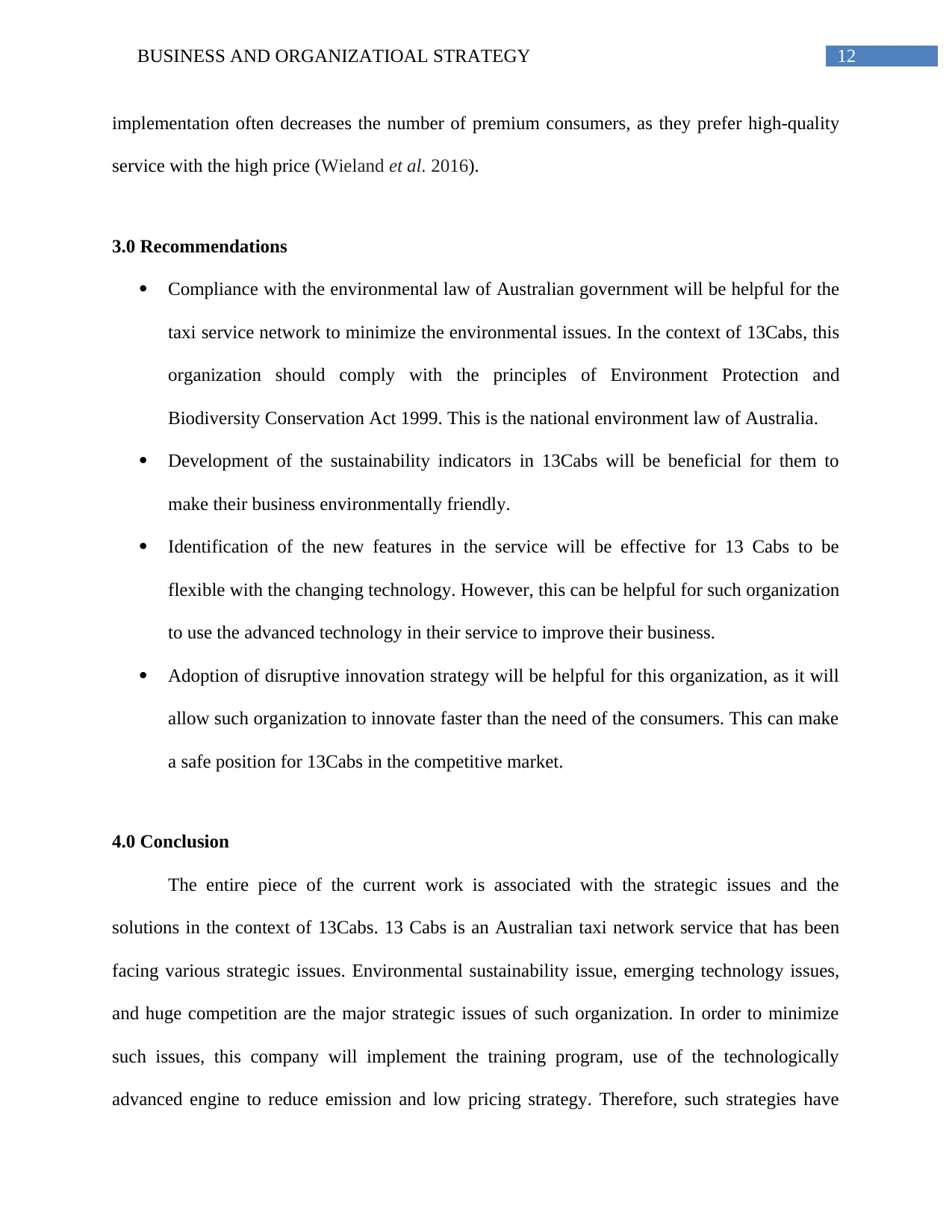
12BUSINESS AND ORGANIZATIOAL STRATEGY
implementation often decreases the number of premium consumers, as they prefer high-quality
service with the high price (Wieland et al. 2016).
3.0 Recommendations
Compliance with the environmental law of Australian government will be helpful for the
taxi service network to minimize the environmental issues. In the context of 13Cabs, this
organization should comply with the principles of Environment Protection and
Biodiversity Conservation Act 1999. This is the national environment law of Australia.
Development of the sustainability indicators in 13Cabs will be beneficial for them to
make their business environmentally friendly.
Identification of the new features in the service will be effective for 13 Cabs to be
flexible with the changing technology. However, this can be helpful for such organization
to use the advanced technology in their service to improve their business.
Adoption of disruptive innovation strategy will be helpful for this organization, as it will
allow such organization to innovate faster than the need of the consumers. This can make
a safe position for 13Cabs in the competitive market.
4.0 Conclusion
The entire piece of the current work is associated with the strategic issues and the
solutions in the context of 13Cabs. 13 Cabs is an Australian taxi network service that has been
facing various strategic issues. Environmental sustainability issue, emerging technology issues,
and huge competition are the major strategic issues of such organization. In order to minimize
such issues, this company will implement the training program, use of the technologically
advanced engine to reduce emission and low pricing strategy. Therefore, such strategies have
implementation often decreases the number of premium consumers, as they prefer high-quality
service with the high price (Wieland et al. 2016).
3.0 Recommendations
Compliance with the environmental law of Australian government will be helpful for the
taxi service network to minimize the environmental issues. In the context of 13Cabs, this
organization should comply with the principles of Environment Protection and
Biodiversity Conservation Act 1999. This is the national environment law of Australia.
Development of the sustainability indicators in 13Cabs will be beneficial for them to
make their business environmentally friendly.
Identification of the new features in the service will be effective for 13 Cabs to be
flexible with the changing technology. However, this can be helpful for such organization
to use the advanced technology in their service to improve their business.
Adoption of disruptive innovation strategy will be helpful for this organization, as it will
allow such organization to innovate faster than the need of the consumers. This can make
a safe position for 13Cabs in the competitive market.
4.0 Conclusion
The entire piece of the current work is associated with the strategic issues and the
solutions in the context of 13Cabs. 13 Cabs is an Australian taxi network service that has been
facing various strategic issues. Environmental sustainability issue, emerging technology issues,
and huge competition are the major strategic issues of such organization. In order to minimize
such issues, this company will implement the training program, use of the technologically
advanced engine to reduce emission and low pricing strategy. Therefore, such strategies have
You're viewing a preview
Unlock full access by subscribing today!
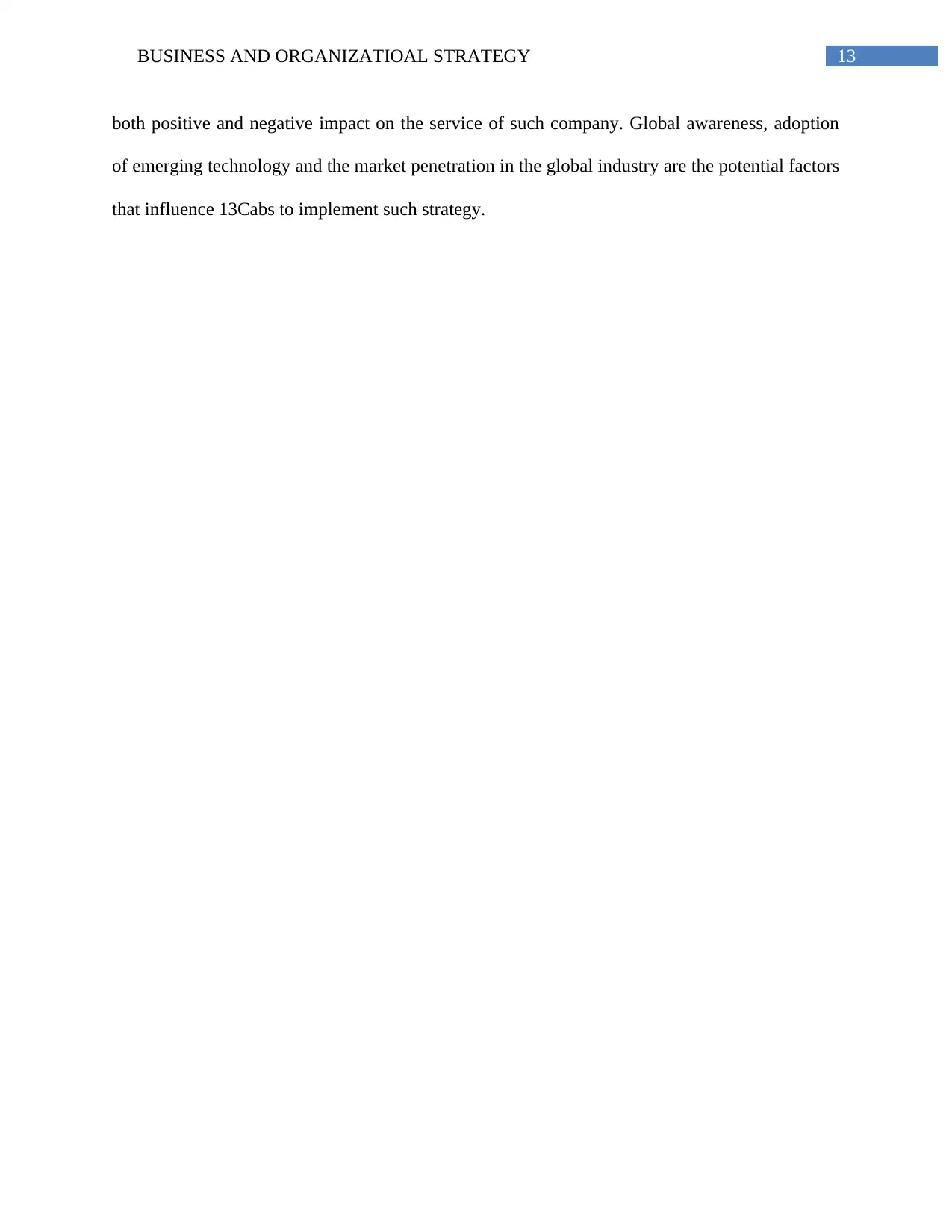
13BUSINESS AND ORGANIZATIOAL STRATEGY
both positive and negative impact on the service of such company. Global awareness, adoption
of emerging technology and the market penetration in the global industry are the potential factors
that influence 13Cabs to implement such strategy.
both positive and negative impact on the service of such company. Global awareness, adoption
of emerging technology and the market penetration in the global industry are the potential factors
that influence 13Cabs to implement such strategy.
Paraphrase This Document
Need a fresh take? Get an instant paraphrase of this document with our AI Paraphraser
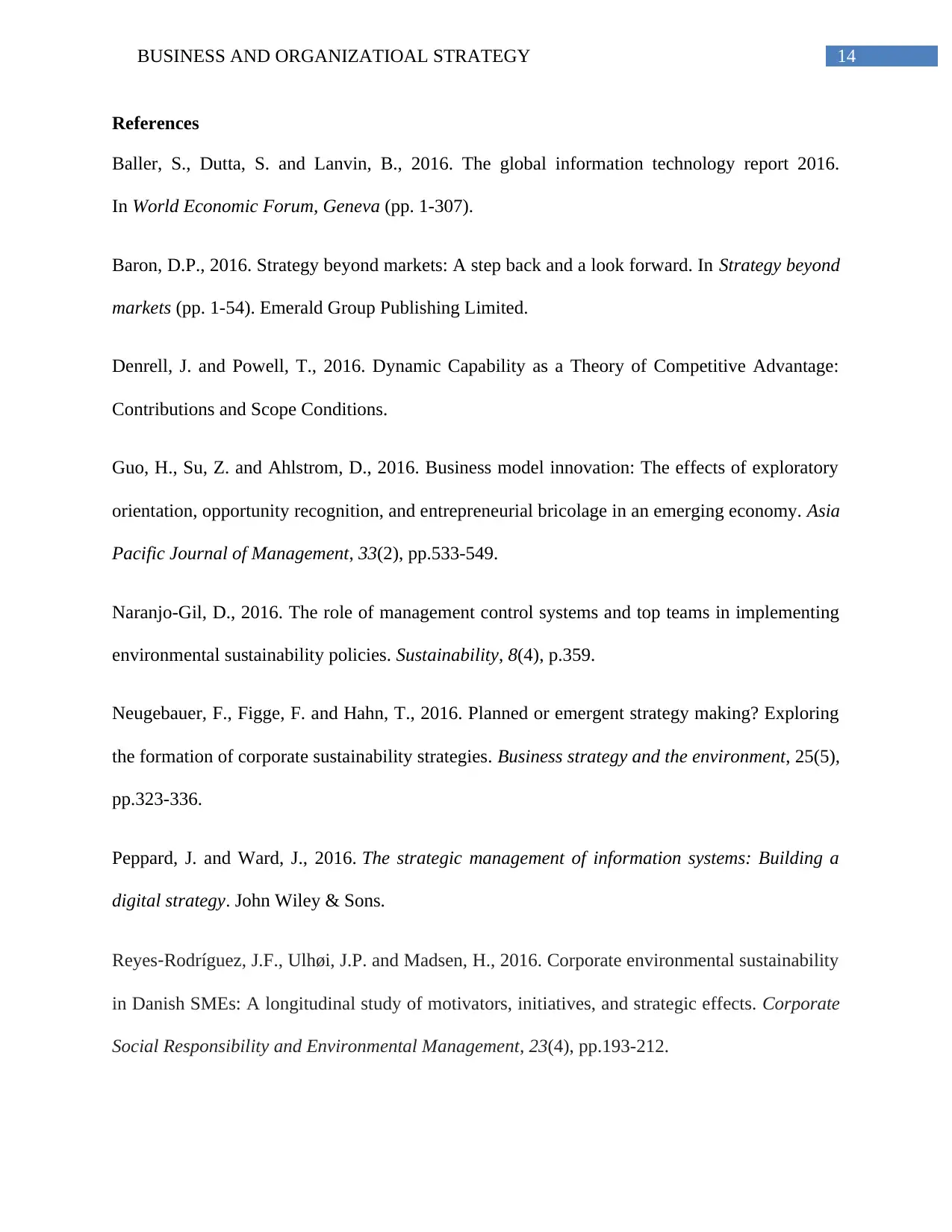
14BUSINESS AND ORGANIZATIOAL STRATEGY
References
Baller, S., Dutta, S. and Lanvin, B., 2016. The global information technology report 2016.
In World Economic Forum, Geneva (pp. 1-307).
Baron, D.P., 2016. Strategy beyond markets: A step back and a look forward. In Strategy beyond
markets (pp. 1-54). Emerald Group Publishing Limited.
Denrell, J. and Powell, T., 2016. Dynamic Capability as a Theory of Competitive Advantage:
Contributions and Scope Conditions.
Guo, H., Su, Z. and Ahlstrom, D., 2016. Business model innovation: The effects of exploratory
orientation, opportunity recognition, and entrepreneurial bricolage in an emerging economy. Asia
Pacific Journal of Management, 33(2), pp.533-549.
Naranjo-Gil, D., 2016. The role of management control systems and top teams in implementing
environmental sustainability policies. Sustainability, 8(4), p.359.
Neugebauer, F., Figge, F. and Hahn, T., 2016. Planned or emergent strategy making? Exploring
the formation of corporate sustainability strategies. Business strategy and the environment, 25(5),
pp.323-336.
Peppard, J. and Ward, J., 2016. The strategic management of information systems: Building a
digital strategy. John Wiley & Sons.
Reyes‐Rodríguez, J.F., Ulhøi, J.P. and Madsen, H., 2016. Corporate environmental sustainability
in Danish SMEs: A longitudinal study of motivators, initiatives, and strategic effects. Corporate
Social Responsibility and Environmental Management, 23(4), pp.193-212.
References
Baller, S., Dutta, S. and Lanvin, B., 2016. The global information technology report 2016.
In World Economic Forum, Geneva (pp. 1-307).
Baron, D.P., 2016. Strategy beyond markets: A step back and a look forward. In Strategy beyond
markets (pp. 1-54). Emerald Group Publishing Limited.
Denrell, J. and Powell, T., 2016. Dynamic Capability as a Theory of Competitive Advantage:
Contributions and Scope Conditions.
Guo, H., Su, Z. and Ahlstrom, D., 2016. Business model innovation: The effects of exploratory
orientation, opportunity recognition, and entrepreneurial bricolage in an emerging economy. Asia
Pacific Journal of Management, 33(2), pp.533-549.
Naranjo-Gil, D., 2016. The role of management control systems and top teams in implementing
environmental sustainability policies. Sustainability, 8(4), p.359.
Neugebauer, F., Figge, F. and Hahn, T., 2016. Planned or emergent strategy making? Exploring
the formation of corporate sustainability strategies. Business strategy and the environment, 25(5),
pp.323-336.
Peppard, J. and Ward, J., 2016. The strategic management of information systems: Building a
digital strategy. John Wiley & Sons.
Reyes‐Rodríguez, J.F., Ulhøi, J.P. and Madsen, H., 2016. Corporate environmental sustainability
in Danish SMEs: A longitudinal study of motivators, initiatives, and strategic effects. Corporate
Social Responsibility and Environmental Management, 23(4), pp.193-212.
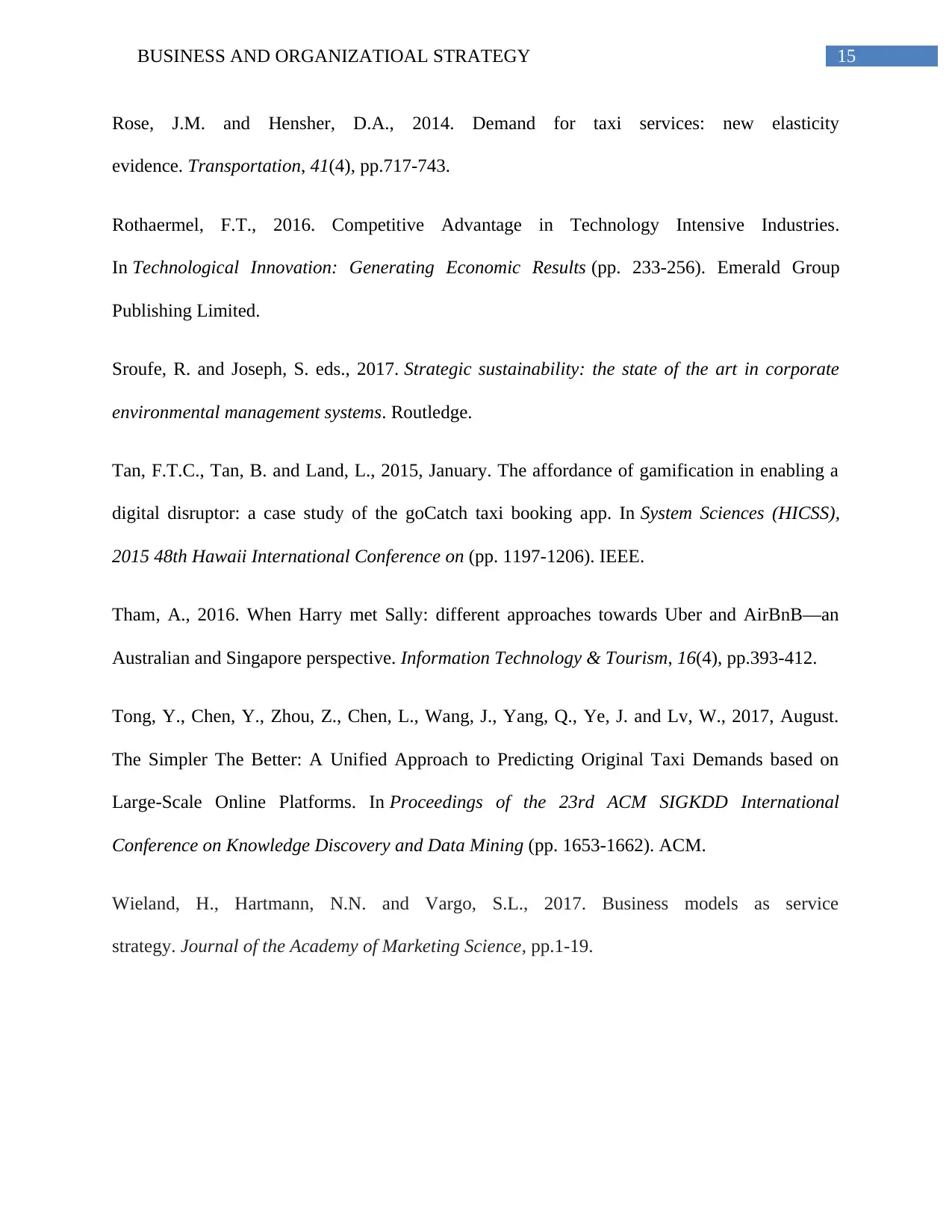
15BUSINESS AND ORGANIZATIOAL STRATEGY
Rose, J.M. and Hensher, D.A., 2014. Demand for taxi services: new elasticity
evidence. Transportation, 41(4), pp.717-743.
Rothaermel, F.T., 2016. Competitive Advantage in Technology Intensive Industries.
In Technological Innovation: Generating Economic Results (pp. 233-256). Emerald Group
Publishing Limited.
Sroufe, R. and Joseph, S. eds., 2017. Strategic sustainability: the state of the art in corporate
environmental management systems. Routledge.
Tan, F.T.C., Tan, B. and Land, L., 2015, January. The affordance of gamification in enabling a
digital disruptor: a case study of the goCatch taxi booking app. In System Sciences (HICSS),
2015 48th Hawaii International Conference on (pp. 1197-1206). IEEE.
Tham, A., 2016. When Harry met Sally: different approaches towards Uber and AirBnB—an
Australian and Singapore perspective. Information Technology & Tourism, 16(4), pp.393-412.
Tong, Y., Chen, Y., Zhou, Z., Chen, L., Wang, J., Yang, Q., Ye, J. and Lv, W., 2017, August.
The Simpler The Better: A Unified Approach to Predicting Original Taxi Demands based on
Large-Scale Online Platforms. In Proceedings of the 23rd ACM SIGKDD International
Conference on Knowledge Discovery and Data Mining (pp. 1653-1662). ACM.
Wieland, H., Hartmann, N.N. and Vargo, S.L., 2017. Business models as service
strategy. Journal of the Academy of Marketing Science, pp.1-19.
Rose, J.M. and Hensher, D.A., 2014. Demand for taxi services: new elasticity
evidence. Transportation, 41(4), pp.717-743.
Rothaermel, F.T., 2016. Competitive Advantage in Technology Intensive Industries.
In Technological Innovation: Generating Economic Results (pp. 233-256). Emerald Group
Publishing Limited.
Sroufe, R. and Joseph, S. eds., 2017. Strategic sustainability: the state of the art in corporate
environmental management systems. Routledge.
Tan, F.T.C., Tan, B. and Land, L., 2015, January. The affordance of gamification in enabling a
digital disruptor: a case study of the goCatch taxi booking app. In System Sciences (HICSS),
2015 48th Hawaii International Conference on (pp. 1197-1206). IEEE.
Tham, A., 2016. When Harry met Sally: different approaches towards Uber and AirBnB—an
Australian and Singapore perspective. Information Technology & Tourism, 16(4), pp.393-412.
Tong, Y., Chen, Y., Zhou, Z., Chen, L., Wang, J., Yang, Q., Ye, J. and Lv, W., 2017, August.
The Simpler The Better: A Unified Approach to Predicting Original Taxi Demands based on
Large-Scale Online Platforms. In Proceedings of the 23rd ACM SIGKDD International
Conference on Knowledge Discovery and Data Mining (pp. 1653-1662). ACM.
Wieland, H., Hartmann, N.N. and Vargo, S.L., 2017. Business models as service
strategy. Journal of the Academy of Marketing Science, pp.1-19.
You're viewing a preview
Unlock full access by subscribing today!
1 out of 15
Related Documents
Your All-in-One AI-Powered Toolkit for Academic Success.
+13062052269
info@desklib.com
Available 24*7 on WhatsApp / Email
![[object Object]](/_next/static/media/star-bottom.7253800d.svg)
Unlock your academic potential
© 2024 | Zucol Services PVT LTD | All rights reserved.




